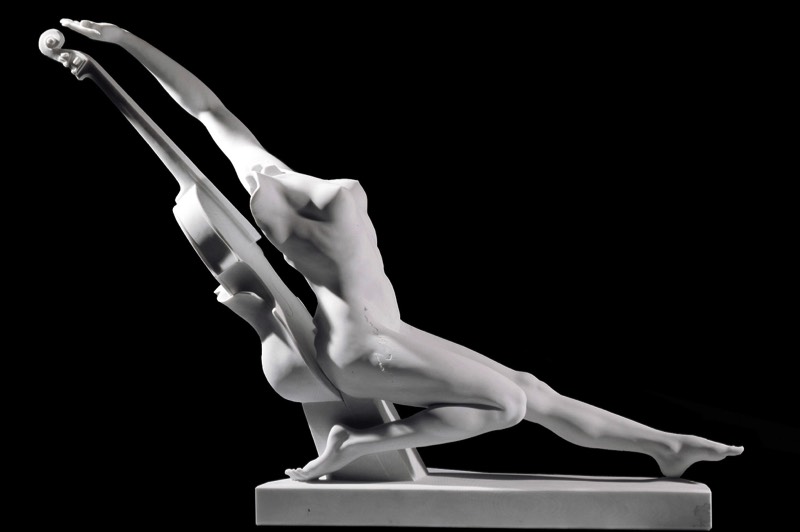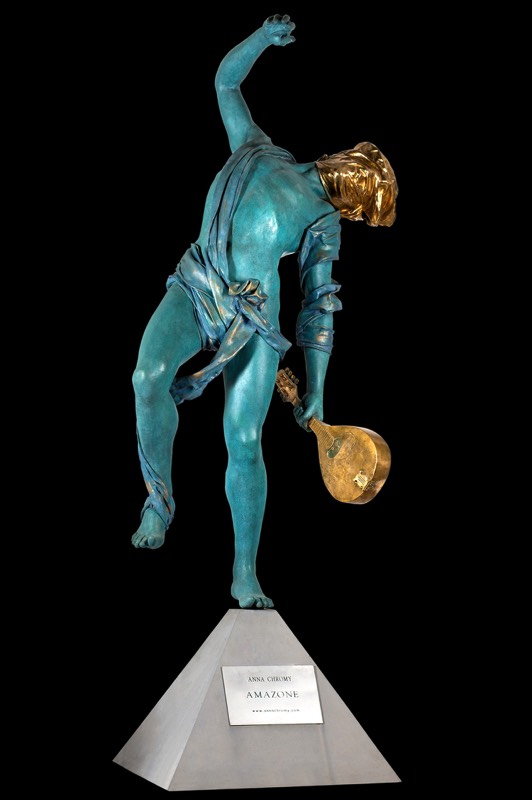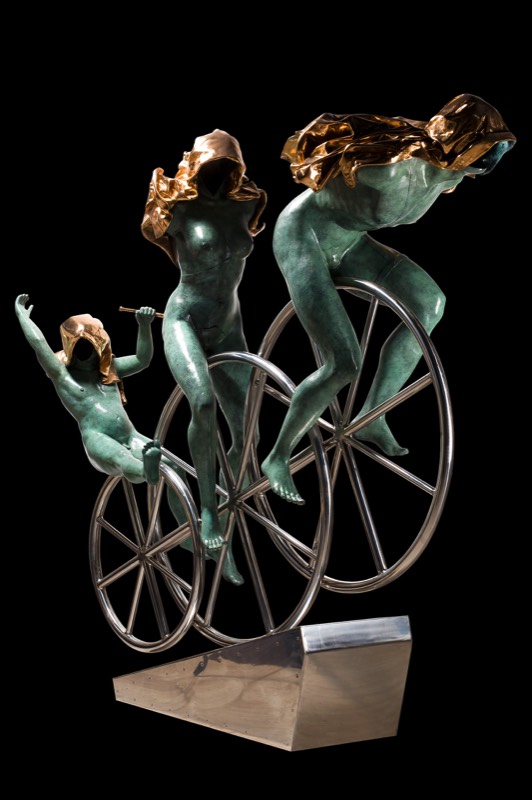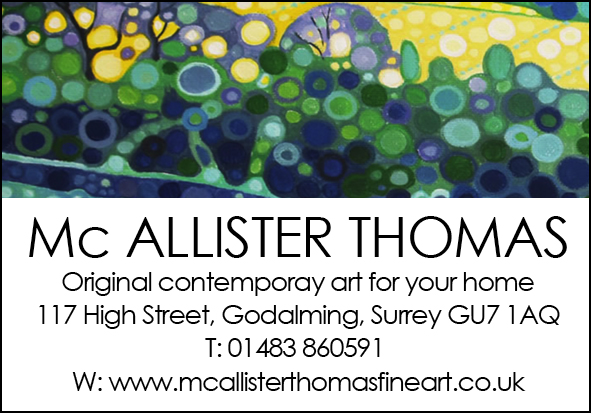ART
Surrey’s Premier Lifestyle Magazine
West meets east
As a consequence of China’s greater global awareness, it’s increasingly turned its cultural gaze in a western direction. Anna Chromy is the renowned artist commissioned by Lord Moynihan to produce the three athletes’ sculpture, Olympic Spirit, for the 2012 London Olympics. In October she became the first western artist to have a solo exhibition at the National Museum in Beijing. essence discovers more about this iconic artist.

Eurydice
Anna Chromy has no fewer than 60 sculptures standing in public places throughout Europe, more than any other artist. Now it’s the Chinese who have fallen in love with her work, honouring her with an exhibition at the prestigious National Museum which fronts Tiananmen Square.
The groundbreaking Chromy Exhibition in Beijing featured 15 of her large sculptures, 20 small sculptures and 30 drawings. Visitor numbers ran at more than 1,500 a day, amongst which were leading Chinese art curators and VIPs who were full of praise for her works. This compliment follows from a previous visit where Anna was guest of honour at the Guangzhou Arts Fair in 2005. Her sculpture, the Violinist Player, was displayed on all official announcements, posters and programmes.
The groundbreaking Chromy Exhibition in Beijing featured 15 of her large sculptures, 20 small sculptures and 30 drawings. Visitor numbers ran at more than 1,500 a day, amongst which were leading Chinese art curators and VIPs who were full of praise for her works. This compliment follows from a previous visit where Anna was guest of honour at the Guangzhou Arts Fair in 2005. Her sculpture, the Violinist Player, was displayed on all official announcements, posters and programmes.
Artist profile
Anna Chromy has been showered in her long career with honours and distinctions, such as the Michelangelo Award in Tuscany and the Dali and Kafka Prizes in Prague. She was made an Honorary Fellow of the National Sculpture Academy of China in Beijing, and she has displayed her works in such prestigious places as the Place Vendôme in Paris and major museums.A painter for many years, Anna suffered a catastrophic accident in 1985 which had a profound effect on her. It sent her in an entirely new direction as she recovered, that direction being sculpture. And the move to sculpture created something monumental – the Cloak of Conscience.
On a special day in June 2005, at a mass for her 40th wedding anniversary, the Abbot of the Holy Monastery of Saint Francis in Assisi asked Anna if she could conceive the Cloak as a space of meditation, according to the words of Saint Francis: “to use in the absence of a consecrated space our own body as a place for prayer and contemplation.”
This was the moment that launched the project that Anna had cherished since her first painting of the Cloak – to create the ‘Stone-Guest’ as a universal symbol of conscience in a dimension never attempted before. To carve this chapel into one single block of white marble, Anna had to wait for a whole year until she received on Christmas Eve 2006 the news that the famous Michelangelo quarry in the Apuan Mountains in Tuscany had finally given birth to an unblemished piece of marble weighing 250 tons.

Amazone
Anna explains her inspiration: “My work starts with respect for the classical sculpture of Greece and Rome, as well as that of Michelangelo and Bernini. The spirit of humanity and our relationship to nature that is central to their work is what drives my own creative process. So it was with interest and fascination that I saw the same principles embodied in Chinese art as I began to understand it. This has encouraged my belief in my artistic mission and has made me so grateful and humble to be acknowledged in China by this distinctive honour of a solo exhibition at the National Museum of China.
I hope with all my heart that my work will in some way help to build cultural bridges between east and west. That would be the most wonderful legacy.”
Her artistic awards are numerous and include the Prize Salvador Dali, Kafka and Masaryk University, and the much-coveted Premio Michelangelo – awarded to a woman for the first time in 2008. She is best known in the UK for the Olympic Village sculpture thought by many athletes to be lucky and much touched (and climbed upon by Australian champion diver Matthew Mitcham). During the 2012 London games, the sculpture stood in front of the Team GB accommodation.
I hope with all my heart that my work will in some way help to build cultural bridges between east and west. That would be the most wonderful legacy.”
Her artistic awards are numerous and include the Prize Salvador Dali, Kafka and Masaryk University, and the much-coveted Premio Michelangelo – awarded to a woman for the first time in 2008. She is best known in the UK for the Olympic Village sculpture thought by many athletes to be lucky and much touched (and climbed upon by Australian champion diver Matthew Mitcham). During the 2012 London games, the sculpture stood in front of the Team GB accommodation.
Today one can criss-cross Europe and never be far from an Anna Chromy sculpture – she has more sculpture on public display than any other living artist. They range from Farnham in Surrey to Luxembourg, Stuttgart, Prague, Salzburg, Munich, Monaco, Milan, Menton, Pisa, Florence and Bologna and for two months in 2005 her works dominated the Place Vendôme in Paris. In Portofino, Italy, Anna’s ‘Dancer’ graces the famous yacht harbour and in Pisa the ‘Myth of Sisyphus’ stands as the symbol of the University.
As a student at the Academy of Fine Arts in Paris Anna met Salvador Dali and recalls: “One day our class was invited to meet the Master at Hotel Meurice in order to show our first works. There he was, sitting next to his wife Gala, my undisputed hero and example to follow in my art. When it was my turn to show a painting to the Master, he took it in his hands and disappeared for a moment into another room. When he reappeared he commented on the work with the words: “You are not a woman. This is the first time I see a woman paint like a man.” Knowing his opinion that women were lacking creativity, I took this as an enormous compliment.”
As a student at the Academy of Fine Arts in Paris Anna met Salvador Dali and recalls: “One day our class was invited to meet the Master at Hotel Meurice in order to show our first works. There he was, sitting next to his wife Gala, my undisputed hero and example to follow in my art. When it was my turn to show a painting to the Master, he took it in his hands and disappeared for a moment into another room. When he reappeared he commented on the work with the words: “You are not a woman. This is the first time I see a woman paint like a man.” Knowing his opinion that women were lacking creativity, I took this as an enormous compliment.”

Sisyphus
Czech born, raised in Austria, studying in Paris, living in Monte Carlo and having studios in Tuscany, Anna has been described as the quintessential European. Her best known work, The Cloak of Conscience, as with her other art, reflects a conscience and deep thought about humanity and the natural flow of life. This is also displayed in her lifetime involvement with the protection of the innocent and poor.
One has to wonder if the Chinese are trying to send a message to the West by honouring Anna Chromy. Maybe we too should touch her works for luck and hope that this exhibition presages a new entente cordial between East and West.
One has to wonder if the Chinese are trying to send a message to the West by honouring Anna Chromy. Maybe we too should touch her works for luck and hope that this exhibition presages a new entente cordial between East and West.
essence info
Website: www.annachromy.com“During my time as co-ordinator for the construction of the Beijing Olympics 2008 buildings and the Centre for the Performing Arts, I was in charge of the sculpture programme as well. In all these years, I have not come across works as powerful and elegant as seen now in Anna’s exhibition in the National Museum of China. Ten years earlier and the City of Beijing would be full of her works. I deeply regret that I have only met Anna Chromy now.”
Wan Siquian, former deputy mayor of Beijing, responsible for the construction of the Olympic Facilities and the National Grand Theatre



